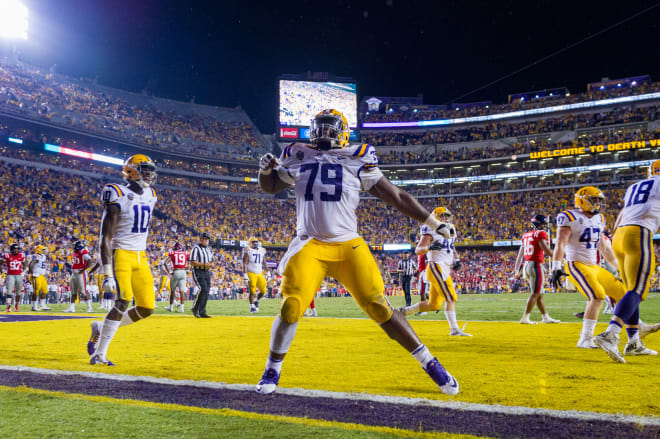As 'focal point' of offense, LSU's OL aims to prove doubters wrong

BATON ROUGE, La. — Tight end Foster Moreau labeled LSU’s line as the focal point of the offense. If that’s the case, then Lloyd Cushenberry III is unquestionably the center of attention.
The Tigers’ offensive line has been the subject of criticism throughout the season. Injuries, attrition and the suspension of a starting guard in August are just a few of the adverse obstacles that have been placed in front of the group over the past three-plus months.
The unit started has featured seven different starting combinations in 10 games, but trotted out the same five against Arkansas for just the second time this season. Barring an unforeseen setback, that trend will continue in the home finale in Tiger Stadium this Saturday against Rice.
With continuity comes success, said Cushenberry, who despite playing next to three different left tackles, three different left guards and three different right tackles, believes the unit has still managed to exceed expectations.
“We weren’t doing well,” Cushenberry admitted. “We were not being dominant like (we) can be. We were slipping up on calls a bit, but we got better from it. We’ve just not been executing to where we need to be, but we got back on track and got a win. That’s the most important thing — to win …
“We’ve played good, but not really consistent. We’ve done well. Coming into the season, people thought we were going to get demolished every game. We’ve held our own in my opinion.”
The offensive line produced its worst game on Nov. 3 against top-ranked Alabama. The unit failed to open running lanes, evident by 12 net rushing yards and allowed five sacks on quarterback Joe Burrow.
They rebounded on the road at Arkansas, allowing Nick Brossette and Clyde Edwards-Helaire to rip off 164 yards on the ground, the team’s most rushing yards since the Oct. 13 defeat of Georgia.
In the second quarter, LSU’s offensive line began to take over at the line of scrimmage. Offensive coordinator Steve Ensminger gave them no other option. Ensminger called for 13 running plays in a 15-play series, which amounted to five first downs and a 12-yard rushing touchdown by Brossette, who was legitimately carried by his linemen into the end zone to double the lead at 14-0.
In a lot of ways, that was how the line rediscovered its earlier form.
“We saw what defense they were playing and we felt like we could pound them a little bit,” Cushenberry said. “We knew we were going to run the ball, but I didn’t think we’d run that many times in a row. We kept rolling with it, but I didn’t know before the drive. As it kept going, we said, ‘Keep it going.’ Most of the players were power plays, and that’s our style."
“That was a good drive,” he laughed.
Now, the task for Cushenberry and the Tigers’ offensive line is turning a 14-play, 77-yard drive into the tone-setter for the final three games of the season.
LSU’s line is as healthy as it has been all year and even reserve linemen are carving out roles. As the “focal point” of the offense, there is certainly pressure on the unit up front to perform well.
Like those that doubted the team, those that doubted the offensive line will be proved wrong, Cushenberry warned.
“Even in our consistency, we’ve found ways to win,” he said. “We felt like coming into this year, we could do this all along. People outside the team didn’t think so, saying we were going to win six games — if that. It would be huge to prove ourselves right and the doubters wrong.”
